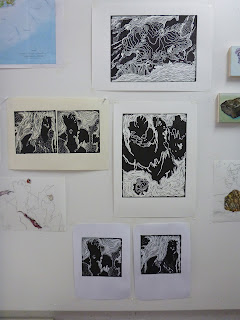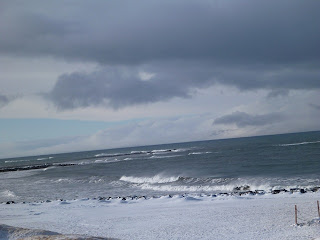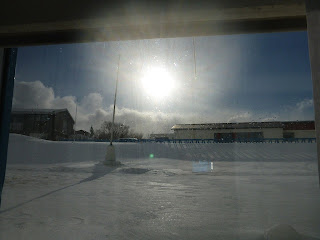Fish Drying in Saudakrouker
Saudakrouker has a rather large fishing business. Along the
edge of the water are wooden fish drying racks – there must be an acre of them.
Heads are separated and hung in a different section from the bodies. The only
wild mammals in Iceland are the Icelandic foxes and the insects, of which there
are few and no mosquitoes, don’t seem interested in saltwater fish. The fish hang out in the open
unmolested by varmints. Industrial scale, clean, practical and rustic all at
the same time.
The smell is pungent but not rotten.
A Limitless Supply of
Beauty
Teaching in an Alien
Tongue
Tarrvi, a graphic artist from Estonia, gave a community
printmaking workshop in the evening. The participants included four local
residents and a French artist. He began with a brief “talk” about printmaking,
using what were at hand, a cork trivet and a carved woodblock, as props to
describe the relief method. His English is halting at best and the
participants, Icelandic and French, had varying degrees of English proficiency,
the highest being not very. This meant Tarrvi used the simplest of terms and
short, fundamental sentences to explain and instruct. He also relied on a lot
of gestures and demonstration, each idea accompanied by a descriptive action.
As he led the group nodded in understanding. Hobbled by layered language
barriers, it was remarkable to watch how uncomplicated and effective his teaching
was.
The recipe was few words and simple language with lots of
showing and acting.
The old adage “A picture is worth a thousand words” was
brought to life. How fitting.
Music
One of the artists, Katelyn Clark (http://katelynclark.com/) is a classically
trained musician specializing in Medieval and Renaissance music. She also plays
contemporary music and composes for the medieval Organetto.
This week she gave a concert in the local church. She plays
the Organetto by balancing it on her knee and compressing the bellows on one
side while playing the tiny keyboard on the other. The keys determine which
pipes are opened and the pressure on the bellows determines volume. That’s the
simple explanation, however Katelyn has developed a technique where she
controls the airflow in ways that create new, vibrating pitches. She played a
medieval piece then one of her own compositions. Listening to her piece was
like hearing the wind, waves, birds, and beach pebbles pulling back from a wave
all in natural conversation. At one point it sounded as if the midnight auroras
were singing.
Here is her instrument, looking just like a tiny medieval
church.
Thursday March 28th
Nes held its monthly open studio this afternoon. For a few
hours local residents, and some from as far as Reykjavik, wandered through our
spaces.
 |
| Studio Wall |
Ollie, who grew up in Skagastrond and is in his late 60’s,
looked at the maps and launched into a story about Iceland and its history. He
remembered as a young child sitting in the main room with extended family in
the evenings and listening to his grandfather read the sagas and tell stories.
Ollie feels that the reason Iceland remained independent from Denmark is
because no matter how rustic the life style, everyone in Iceland learned how to
read. The entire small, mostly rural population from the 16th
century on was literate.
It was interesting to see how the drawings and maps
triggered his sense of memory and national history.
My Work
Today, Saturday the 30th, is my last day in the
studio.
One of the first things I did when I arrived was to put a
map of Iceland on the studio wall and then trace the large school map that
belongs to Nes. I used 18 pieces of 11 x 14 paper that I will reassemble in my
studio at home.
I like the way geographic and geological information, when
traced, can become drawing. It’s not coping because the function of the
original is never in play. Nor is it a drawing of a map. It is like a
footprint, and I imagine as I trace, walking the land.
Wallace Steven’s poem “Anecdote of the Jar” comes to mind
when I think about distributing rocks from foreign territory in the Icelandic
landscape. When placing a jar
on a Tennessee hill, Stevens sees
that “The wilderness rose up to it,” and “It took dominion everywhere.”
Here are the thirteen stones that will be placed along the
way as I travel from Northern Iceland around the east, down through the
southern coast and finally to the airport on the western Raykjanes peninsula. The
stones come from Greece, Mongolia, NYC, Florida, Arizona, New Mexico, California
and Lithuania.
Each stone has had its portrait painted and its information
recorded.
This stone is from the Greek island Samos and was found on
Balos Beach.
Here are more examples of work I have done since coming to Nes.
 | ||
| Linoleum Prints |
 | ||
| Stone Portraits |
Below are two of my favorite daily drawings.














































.jpg)






